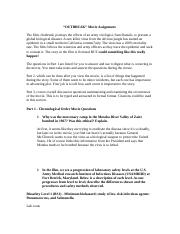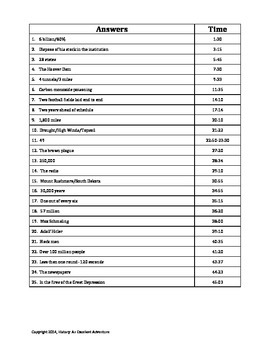Viewing Guide To Outbreak Movie Answer Key

FEATURED LESSON PLAN: The Outbreak
Viewing guide answer key: the goliath beetle and Viewing Guide Answer Key: The Goliath Beetle and the Big Lift While watching the video, circle the correct answers. PDF Mazda Metro Service Manual.pdf Newsies viewing guide answer key - manualsilo Newsies Viewing Guide Answer Key Newsies Viewing Guide Answer Key.pdf Viewing Guide Medici.
Overview:
In this lesson, students will watch the first chapter of the program, conduct a simulation to see how disease spreads in a community with and without vaccine immunity, and take part in a survey on views about vaccination. In doing so, they will consider some of the personal and societal aspects of decisions about vaccinating children. (For background information on vaccination, see “How Do Vaccines Work?” and other Related Resources.

Note: Students may have strong feelings about this issue based on their family history, parental viewpoint, religious background or other factors. Please ensure the discussion is respectful of different perspectives.
Subject Area:
Health, Biology, English, Social Studies, U.S. Government
Grade Level:
Grades 7-12
Objectives:
- The student will:
- Identify different perspectives on vaccinating children
- Develop an understanding of how disease is transmitted in a population with and without vaccine immunity
- Examine different views on the risks and benefits of vaccines
- Consider the balance between individual choice and public good involved in the question of vaccination
Estimated Time Needed:
Shortcut keys for windows 7. One to two 50-minute class periods
Materials Needed:
- Internet access and equipment to show the class an online video clip and complete a survey
- Chapter One of The Vaccine War: “A Visit to Ashland, Oregon”
- Handout 1: Outbreak (PDF file)
- Small folded pieces of paper or index cards, one for each student, half with “V” written on them and half with “S”
- Handout 2 (optional): Where Do You Stand on Vaccines? (PDF file)
Procedure:
Video Chapter
Real rock return riddim rare 2017. If Yuh No Like We1992We Nuh Borrow Gun1992Lloyd ‘King Jammy’ JamesInformer1992Lloyd ‘King Jammy’ James&So Long You Wrong1992Winston ‘Niney The Observer’ HolnessNo Ice Cream Sound1992Lloyd ‘King Jammy’ JamesBonanza1992Lloyd ‘King Jammy’ JamesPastor Man1992Cedrica Anthony ‘Soljie’ HamiltonHunuh Fe Cool1992Paul ‘Jah Screw’ LoveOriginal Lyrics1992Lloyd ‘King Jammy’ JamesGood Hole College1992Lloyd ‘King Jammy’ JamesModelling1992Lloyd ‘King Jammy’ JamesMr.
- Ask students what they think vaccines are and how they might work. If they are not sure, explain that vaccines act with the body’s immune system to protect against disease. Point out that when the body is exposed to an infectious disease, it creates antibodies that can neutralize or destroy that particular disease. A vaccine is a weakened form of the disease that enables people to become immune to the disease without getting sick from it.
- Explain that the class will watch a segment of FRONTLINE’s The Vaccine War, which introduces two perspectives on whether children should be vaccinated. Ask students what they think the two perspectives might be.
- Show Chapter One of The Vaccine War: “A Trip to Ashland, Oregon.” As they watch, have students use a T-chart labeled “Favors Vaccines” and “Opposes Vaccines” to jot down words or phrases used in the video by people from the two viewpoints.
- Ask students: “What perspectives on vaccinating children are presented in the chapter? Why do some parents choose not to vaccinate their children? What might be some of the consequences of that decision?”
Infectivitis Simulation
- Round 1 - Without Vaccination
- Remind students of the measles outbreak described in the video. Ask, “How could so many people be affected when just one person was initially infected?”
- Give students copies of the Outbreak student handout and explain that the class will simulate how disease spreads in a community. Read the description of Infectivitis, making sure students understand its three-day progression and the motions they will use to signify their status.
- Choose a student sitting near the center of the class to introduce Infectivitis to the community. That student should put both hands on the head as described in the student handout. Point out that this is Day 1 of Round 1. Count the number of people currently sick and have students record it on the handout.
- Remind students that the sick person is contagious and spreads the disease by tagging one person while remaining seated. Announce the end of Day 1.
- Continue in this manner, and each day of the round, do the following:
- Announce the beginning of the day
- Remind sick students to change their status as the disease progresses
- Count and record the number of sick people
- Have sick people tag one susceptible student they can reach from their seat
- Announce the end of the day
- The round ends either when all students have had Infectivitis or when transmission stops because there is no one left to tag. Count and record the number of students who were sick and who were never sick during the round. Round 2 - With Vaccination
- Tell students that they will do the simulation again, but this time half of the students will be immune to Infectivitis because they were vaccinated for it. As in real life, students will not be able to tell who is immune and who is susceptible.
- Distribute the folded cards and have students look at, but not share with anyone, what their card says. Students with “V” have been vaccinated and are immune, and students with “S” are susceptible. Have students write “50% Immune” and “50% Susceptible” on Round 2 of the student handout.
- Conduct the simulation as before, except in this round, when immune students are tagged, they should hold up their “V” card. The people who tagged them do not get to tag anyone else, and the vaccinated students will not tag another student. (Note: If the student you choose to start the round has been vaccinated, the round will end immediately. You may want to conduct another round.)
- Lead students in a discussion about the simulation, asking questions such as:
- What observations can you make about disease transmission from the simulation?
- Why did some people never get sick in Round 2?
- Herd immunity prevents a disease from spreading because a large percentage of the population is immune to the disease as a result of vaccination. How does herd immunity benefit individuals who are not vaccinated?
- What might happen if fewer people or more people were vaccinated? (If you have time, you may want to run more rounds with these scenarios to find out.)
- As the video points out, there are some risks associated with vaccinations. A few people have reactions ranging from rash to serious illness. How would you weigh the risks to an individual of getting the disease versus the risks of the vaccine itself? How would you weigh those risks against the benefit to society as a whole?
Discussion
Survey: Where Do You Stand On Vaccines?
- Explain to students that FRONTLINE’s The Vaccine War website includes a national survey that was conducted in February 2010 to determine views on vaccinating children. Have students answer key questions from the survey either online or by completing copies of the Where Do You Stand on Vaccines? handout.
- Have students compare their responses to the survey results reported on the website.
Credits:
This teacher’s guide was developed by Cari Ladd. It was written by Leslie Comnes. Advisers were Megan Palevich of Montgomery School in Chester Springs, Pa., and Mark Pearcy of Braden River High in Bradenton, Fla.
The idea for the simulation in the lesson plan came from “Protecting the Herd,” Emerging and Re-Emerging Infectious Diseases, by Joseph D. McInerney and Lynda B. Micikas. National Institutes of Health, National Institute of Allergy and Infectious Diseases (NIH Publication No 99-4645), 1999. Available at: http://science-education.nih.gov/supplements/nih1/diseases/guide/pdfs/NIH_Diseases.pdf
- пятница 01 мая
- 40